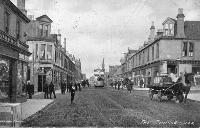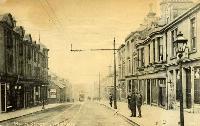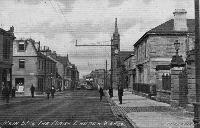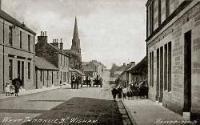Wishaw is not mentioned in the First Statistical Account 1791-99, only ” a village on the lands of Wishaw and Coltness..(which) had no existence 20 years ago”. The abundance of coal in the parish of Cambusnethan is noted. By the second statistical account in 1845, Wishawtown and Stewarttown are listed as the chief village of the parish with a population of 1700. Wishawtown was built on the Wishaw estate of Robert Hamilton, and Stewartown on the Coltness estate of Sir James Stewart.
Early collieries in the area included the Distillery Pit which was the first pit in the area to use steam haulage, and the Quarry Pit. The Coltness Ironworks were opened in the 1830s. However it was the opening of the Wishaw and Coltness Railway in the 1840s which allowed the expansion of mining in the area. Between 1841 and 1851 the population doubled to over 4000 and new settlements including Craigneuk, Newmains, Overtown and Waterloo grew up.
Wishaw, a town in Cambusnethan and Dalziel parishes, constituted a police burgh in 1855, and extended in 1874 so as to comprise Wishaw proper, Cambusnethan village and Craigneuk village. Wishaw, standing 420 feet above sea-level, within two miles of the Clyde’s right bank, and half-a-mile south of South Calder water, has a station on a section (1880) of the Caledonian, constructed at a cost of £150,000 and extending six miles north-westward from Law Junction to Carfin. It is 3 3/4 miles ESE of Motherwell, 5E of Hamilton, 15 ESE of Glasgow, and 32 WSW of Edinburgh. Laid out in 1794 and pleasantly situated on the south-west face of a hill, it was so late as 1840 merely a large village, but since has grown rapidly to the dimensions of a considerable though straggling town, and is the centre of a vast Mineral trade. It has a Post Office, with money order, savings bank, and telegraph department, branches of the British Linen Company, Clydesdale, Commercial, and Royal Banks, 24 Insurance agencies, 3 hotels, gas works, a town hall, a public library, public park, Saturday liberal newspaper, the Wishaw Press (1876), fairs on the second Thursday of May and the fourth Thursday of October etc. The established Church has four places of worship, the Free Church two, the United Presbyterian two, and there are also Reformed Presbyterian, Primitive Methodist, Evangelical Union, Baptist and Roman Catholic churches. Of schools there are nine, six of them under the school board. Few Scottish towns have grown rapidly than Wishaw such growth been due to the great expansion of its Mineral Industries. These, at the census of 1881, employed 2294 of the 3670 persons here of the ‘industrial class’ – 1687 in coal mining, 332 in iron manufacture. The burgh is governed by a chief and two junior magistrates and by nine police commissioners. A sheriff small debt court is held every third Thursday and a police court on every Monday or as occasion required, Municipal voters (1885) 1714. Valuation (1858) £8740, (1882) £23, 800 (1885), £26,500. Pop of Wishaw proper (1841) 2149, (1851) 3271 (1861) 6112, (1871) 8812, (1881)8953; of extended police burgh (1881) 13,112, of whom 6929 were males and 1829 were in Cambusnethan, 2330 in Craigneuk. Houses in burgh (1881) 2532 inhabited, 369 vacant, 12 buildings – Ord Sur., sh. 23, 1865
Waterloo, a village in Cambusnethan parish, 1 mile SE of Wishaw. Pop (1871) 633, (1881) 855
Overtown, a large village in Cambusnethan parish, Lanarkshire, near a station of its own name on the Caledonian railway, 1 1/2 mile SE of Wishaw, and 3 1/2 miles NW of Carluke. Lying amid a rich mineral country, and inhabited chiefly by workers in the mineral field, it has a post office under Wishaw, a school of the Coltness Iron Co., a Roman Catholic school, St Patrick’s Roman Catholic Church (1873; 200 sittings), and an Established church. The last, built in 1874 – 75 at a cost of over £2000, is an early English edifice, with a bold square tower 80 feet high, and 600 sittings. Pop. (1861) 364, (1871) 1517, (1881) 1293.
Allanton, a mansion and estate in Cambusnethan parish, Lanarkshire, 2 miles NE of Newmains station. Having passed to his ancestors from Arbroath Abbey, it is a seat of Sir H. J. Seton-Steuart, seventeenth in descent from Alexander Stewart, fourth Lord High Steward of Scotland: third Baronet since 1814: and owner of 2673 acres, of £4076 (£2197 minerals) annual value, in the shire. The original castellated building, said to have been visited by Cromwell in 1650, was greatly enlarged by Gillespie Graham in the latter half of last century. A fine large park, with a picturesque lake, surrounds it: and the estate is rich in coal and ironstone.
Berryhill, a place, with public school, in Cambusnethan parish, Lanarkshire. The school, with accommodation for 400 children, had (1879) an average attendance of 300, and a grant of £270, 6s.
Bonkle, a village in Cambusnethan parish, Lanarkshire, in a picturesque situation on the Allanton estate, 3 miles ENE of Wishaw. A U.P. church here was built in 1818, and contains 560 sittings.
Cambusnethan, a village and a parish in the Middle Ward of Lanarkshire. The village, now incorporated in Wishaw police burgh, stands 1 mile WSW of Newmains station, and 1 mile NE of Wishaw station; contains a masonic hall, the parish church, a Free church, and a public school; and has fairs on the second Thursday of May and the fourth Thursday of October. The parish church, with 1082 sittings, is a plain Gothic structure, built in 1839 and enlarged in 1875; the public school, with accommodation for 389 children, had (1880) an average attendance of 370, and a grant of £371,15s. The parish contains also the towns and villages of Wishaw, Newmains, Overtown, Coltness Iron-works, Clydesdale-Rows, Chapel, Stane, Morningside, Waterloo, Bonkle, and part of Shotts Iron-works. It is bounded N by Shotts, E by Whitburn in Linlithgowshire and West Calder in Edinburghshire, SE by Carstairs, S by Carluke, SW by Dalserf and Hamilton, and W by Dalziel. Its greatest length, from E to W, is 7¾ miles; its breadth, from N to S, varies between 1 3/4 and 4 miles; and its area is 16,708 acres, of which 100 1/2 are water. The Clyde traces all the south-western boundary; the South Calder most of the northern, and the Garrion traces part of the southern, boundary; whilst four burns running eastward to Breich Water drain the north-eastern end. The tract along the Clyde is low and level, consisting of beautiful fertile haughs, and sinking to less than 100 feet above sea-level; the surface thence has a general eastward rise, attaining 386 feet near West Netherton, 458 at Wemysshill, 570 near Newmains, 680 at Gallowhill, 844 near Springhill, and 950 on Auchterhead Muir. From the church at the village, one can see no fewer than 15 other parish churches; the line of the Caledonian railway, along the brow of the acclivities above the haughs upon the Clyde, looks over great part of Clydesdale; and the heights in the NE command views so extensive as to include the castles of Edinburgh and Dumbarton, Tinto and Loudoun Hills, and the Argyllshire mountains. The tracts near the Clyde and South Calder, and parts of the interior are finely embellished with wood; the central parts, though naturally rich in aspect, are disfigured by mining operations, mineral works, and coal traffic; the eastern and north-eastern district is bleak and moorish. The rocks of great part of the parish belong to the Carboniferous formation, and are rich in good coal, valuable blackband ironstone, and excellent sandstone. Coal, worked in many places and to a vast amount, is exported E and W by all the railways. Blackband ironstone is found on the estates of Coltness and Allanton, and in the neighbourhood of Headlesscross; and supplies blast-furnaces of the Shotts Iron Company at Stane. Clay of excellent quality, in deposits generally 10 feet thick, abounds, and is used for very extensive tile-works at Wishaw and at Coltness. Cambusnethan House stands near the Clyde. amid charming grounds, at the ravine of Hall Gill, 1 1/4 mile SW of Wishaw station. Built in 1819, after designs by Gillespie Graham, it is an elegant Gothic edifice in imitation of a priory, and is the seat of MajorGen. Graeme Alex. Lockhart (b. 1820; suc. 1873). Other chief mansions are Wishaw House, Coltness, Allanton, and Muirhouse. Twelve proprietors hold each an annual value of £500 and upwards, 43 of between £100 and £500,66 of from £50 to £100, and 121 of from £20 to £50. The entire parish was anciently one barony belonging to the Bairds, from whom it passed to successively the Stewarts and the Somervilles. The ancient parish church stood in a very romantic spot, in the near vicinity of the Clyde, at the SW point of the parish; seems to have been built at a very remote period for the accommodation of the family occupying the original mansion of Cambusnethan; and is now represented by a mere fragment, showing some remains of architectural magnificence. Another old place of worship, which has left no vestiges, stood towards the centre of the parish, at a place still called Chapel; and a third, where the famous Covenanting ministers Cameron and Renwick preached, stood at Darmead Linn, in the extreme NE. Cambusnethan is now in the presbytery of Hamilton and synod of Glasgow and Ayr; and is divided among the quoad sacra parishes of Cambusnethan, Calderhead, Wishaw, and Overtown, the first being a living worth £464. Under a schoolboard for the entire parish there are 13 schools, viz. 5 at Wishaw, and others of Berryhill, Cambusnethan, Morningside, Waterloo, Coltness Iron Company (Overtown), Coltness Iron-works (Newmains), Overtown, and Newmains. With total accommodation for 4234 children, these had (1880) an average attendance of 3621, and grants amounting to £3331,1s. 10d. Valuation (1860) £69,222, (1881) £91,036,16s. Pop. (1801) 1972, (1831) 3824, (1841) 5796, (1861) 14,601, (1871) 20,326, (1881) 20,824; of registration district (1871) 18,709, (1881) 19,287.—Ord. Sur., sh. 23. 1865. See the Rev. P. Brown’s Historical Sketches of the Parish of Cambusnethan (Wishaw, 1859).
Chapel, a village in Cambusnethan parish, Lanarkshire, near Newmains.
Morningside, a mining village in Cambusnethan parish, Lanarkshire, with stations on branch lines of both the Caledonian and North British railways, 3 miles by road E by N of Wishaw, and 7 by railway SSE of Holytown. It has a post and telegraph office and a public school. Pop. (1861) 780, (1871) 428, (1881) 740.—Ord. Sur., sh. 23, 1865.
Newmains, a small town in Cambusnethan parish, Lanarkshire, on the cross-railway from Morningside to Holytown, adjacent to the Coltness Ironworks, 2 miles ENE of Wishaw, and 6 by railway SE of Holytown. Standing amid a rich mineral tract, and inhabited chiefly by miners and ironworkers, it has a post office, with money order, savings’ bank, and telegraph departments, a railway station, the Coltness memorial quoad sacra church (1878), St Bridget’s Roman Catholic church (1871; 300 sittings), a Roman Catholic school, and an elegant edifice, erected by the Coltness Ironworks Company at a cost of £3000, to serve as both a school and a chapel of ease. The school affords regular instruction, under a full staff of teachers, to over 600 children, and is maintained by the Ironworks Company. Pop., jointly with Coltness Ironworks, (1861) 2020, (1871) 2545, (1881) 2682, of whom 1445 were males. Houses (1881) 478 occupied, 35 vacant.—Ord. Sur., sh. 23, 1865.



